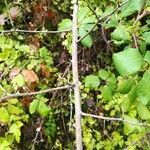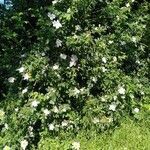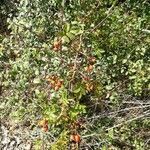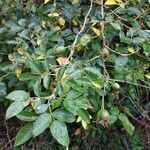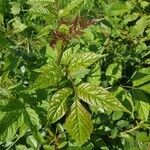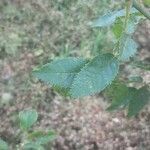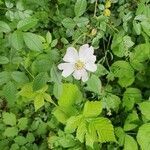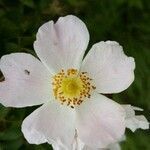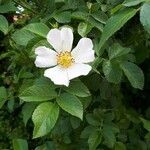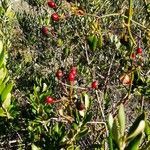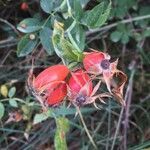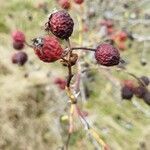Shrubs, arching, not rhizomatous. Stems usually erect to sprawling, 10–25(–50) dm; distal branches arching, bark green; infrastipular prickles paired, curved or appressed, 6–7 × 4–9 mm, lengths ± uniform, internodal prickles rare, single, rarely absent. Leaves deciduous, 6–11 cm; stipules 10–22 × 3–5 mm, auricles 3–5 mm, margins stipitate-glandular or eglandular, surfaces glabrous, eglandular or sparsely stipitate-glandular; petiole and rachis sometimes with pricklets, glabrous, eglandular; leaflets 5–7, terminal: petiolule 5–11 mm, blade ovate, obovate, or elliptic, 15–40 × 12–20 mm, base obtuse to slightly cuneate, margins 1-or multi-serrate, teeth 20–30 per side, apex acute, sometimes acuminate, abaxial surfaces glabrous, rarely pubescent or tomentose on midveins, eglandular, adaxial dark green to green, lustrous to dull, glabrous, rarely tomentose. Inflorescences panicles, sometimes corymbs, solitary, sometimes 2 or 3(–7)-flowered. Pedicels erect to reflexed as hips mature, 8–20 mm, eglandular or stipitate-glandular; bracts 2, ovate-lanceolate, 6–18 × 4–5 mm, margins glandular-serrate, abaxial surfaces puberulent, adaxial surfaces glabrous, eglandular. Flowers 3.5–5 cm diam.; hypanthium narrowly urceolate, 7–9 × 3–6 mm, eglandular, neck 2–3 × 1–2 mm; sepals appressed-reflexed, spreading, or erect, ovate-lanceolate, 10–17 × 3–5 mm, margins deeply pinnatifid, tip 4–6 × 0.5 mm, abaxially eglandular; petals rose, pink, or white, ?sweet-scented?, 18–25 × 15–18 mm; carpels 26–36, styles villous, exsert 1–2 mm beyond stylar orifice (0.7–1.5 mm diam.) of hypanthial disc (4–5 mm diam.). Hips red, globose, ovoid, urceolate, or ellipsoid, 10–16(–24) × 6–16 mm, glabrous, eglandular; sepals deciduous as hips mature, reflexed. Achenes 14–23, tan, 5–6 × 3–3.5 mm. 2n = 35.
More
Deciduous, ± spreading and sometimes semi-scrambling shrub to 3.5 m high, often with suckers; stems usually suberect to spreading, arching in young plants, glabrous; armature of uniform, scattered to moderately abundant, flattened and slightly curved prickles; acicles 0. Lvs with 2-3-(4) pairs of leaflets; petiole usually 15-35-(40) mm long, glabrous or sometimes with sparse glandular hairs; stipules adnate for most of length, glabrous, the denticulate teeth black-tipped. Lamina of leaflets (15)-18-40-(50) × 8-27-(30) mm, elliptic, broad-elliptic, or ovate-elliptic, dull green and glabrous above, sometimes with a few hairs near base, usually glabrous beneath, sometimes hairy, especially on veins and midrib; margins sharply serrate with short acuminate teeth; base rounded; apex acute or subacute, sometimes rounded or shortly acuminate. Fls 1-4-(5), single, 30-55 mm diam.; pedicels glabrous, rarely with scattered glandular hairs. Sepals deciduous, lanceolate, oblong-lanceolate or ovate-lanceolate, long-acuminate, sometimes with an expanded apex, puberulent to tomentose inside, usually glabrous outside, rarely with scattered short glandular hairs; outer sepals with a few long linear lobes. Petals 13-23-(28) mm long, obovate, usually white, rarely pale pink, usually with yellowish base when young. Styles free, usually shortly exserted, sometimes well-exserted, glabrous or hairy. Fr. 12-23 mm diam., ± globose to ellipsoid, glabrous, orange-red or red.
Arching shrub 1–3 m, the stems armed with stout, flattened, hooked prickles; stipules of the principal lvs linear, those of the uppermost lvs dilated, to 4 mm wide; lfls 5 or 7, ovate-elliptic, 2–4 cm, glabrous or with a few deciduous glands on the main veins beneath; pedicels and hypanthium usually glabrous; wall of the hypanthium conspicuously thickened around the very narrow orifice; fls 1–4, long-pedicellate; sep soon reflexed, then deciduous; pet 1.5–2.5(–3) cm, pink to white; styles shortly exserted; 2n=35. Native of Europe, escaped from cult. here and there in our range.
A prickly creeping shrub. It develops suckers. It grows 3 m high and spreads 3 m wide. The stems are prickly. The leaves are opposite and have leaflets along the stalk. The leaves have 5-7 leaflets. The flowers have a scent. The flowers are pale pink and occur singly. The fruit are orange-red hips.
Hedges, scrub, woods, roadsides, banks etc. Forest edges and thinned-out forests, shrubs, open slopes, banks of mountain streams and brooks, felled areas, pastures, roadsides, fences.
More
It is a temperate plant. It does best in dry loamy soils and an open sunny position. It suits hardiness zones 3-10. Tasmania Herbarium. Arboretum Tasmania.
The young shoots are used in soups and sauces. The fruit are used in jams, syrup, soup, jellies, wine and tea. They are also eaten raw. The flowers are used as a snack or in salads. They can be candied, preserved, crystallised or added to vinegar, honey, brandy etc. They are also used for herbal tea. The leaves are used as a tea substitute.
